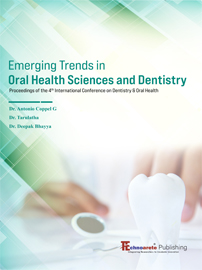


Post graduate student, Department of Pediatric and preventive dentistry, Chettinad dental college and Research Institute, Chennai, India, postcode-603103;
Corresponding Author: meena9thmay1997@gmail.com;
Professor and Head, Department of Pediatric and preventive dentistry, Chettinad dental college and Research Institute, Chennai, India, postcode-603103;
Corresponding Author: ayaswathi@gmail.com;
Professor, Department of Pediatric and Preventive Dentistry, Chettinad Dental College and Research Institute, Chennai, India, 603103;
Corresponding Author: dr.eaga_ars@yahoo.com
Department of Pedodontics and Preventive Dentistry, Chettinad Dental College & Research Institute, Rajiv Gandhi Salai, Kelambakkam, Kancheepuram District, Tamil Nadu – 603 103, India
Dental caries is a widespread, chronic, and infectious condition that affects both deciduous and permanent teeth.[1] Dental caries in primary teeth if left untreated invade the pulp tissue and lead to pulpal infection.[2]There are only two treatment modalities to treat the infected pulp one is pulp therapy and the other is the extraction of the infected teeth.[3] The fundamental goal of pulp therapy is to retain the primary teeth in place until they exfoliate, acting as a natural space maintainer until the successor teeth erupts. [4] Pulpectomy is done to treat the nonvital or irreversibly inflamed teeth in which the inflamed tissue is debrided and the pulp canals are filled with a resorbable material.[5]The main criteria for an obturation material are that it should have good antimicrobial properties against oral microbes.[6]The gold standard and traditional material with good antimicrobial properties for obturating a primary tooth is zinc oxide eugenol.[7] Zinc oxide eugenol has drawbacks, such as irritating the tissues of the periapical area, causing cemental and bone necrosis, and exhibiting different resorption rates compared to the normal physiological resorption of primary teeth. These properties were found to be from the eugenol component.[8 9 10] Hence many authors have attempted to replace the eugenol component with various herbal formulations to reduce its limitations.
[1] Hu J, Jiang W, Lin X, Zhu H, Zhou N, Chen Y, Wu W, Zhang D, Chen H. Dental caries status and caries risk factors in students ages 12–14 years in Zhejiang, China. Medical science monitor: international medical journal of experimental and clinical research. 2018;24:3670
[2] Wagle M, D’Antonio F, Reierth E, Basnet P, Trovik TA, Orsini G, Manzoli L, Acharya G. Dental caries and preterm birth: a systematic review and meta-analysis. BMJ open. 2018 Mar 1;8(3):e018556
[3] . Wagle M, D’Antonio F, Reierth E, Basnet P, Trovik TA, Orsini G, Manzoli L, Acharya G. Dental caries and preterm birth: a systematic review and meta-analysis. BMJ open. 2018 Mar 1;8(3):e018556
[4] .Clifton O, et al. Endodontic therapy for primary teeth. Ingles endodontics.2006;3:39;1400- 1430.
[5] American Academy of Pediatric Dentistry. Guideline on pulp therapy for primary and immature permanent teeth. Pediatr Dent. 2009;31:179-86
[6] Rifkin A. The root canal treatment of abscessed primary teeth--a three to four year follow-up. ASDC journal of dentistry for children. 1982 Nov 1;49(6):428-31
[7] Rifkin A. The root canal treatment of abscessed primary teeth--a three to four year follow-up. ASDC journal of dentistry for children. 1982 Nov 1;49(6):428-31
[8] Spedding RH. Incomplete resorption of resorbable zinc oxide root canal fillings in primary teeth: report of two cases. ASDCJournal of dentistry for children. 1985 May 1;52(3):214-6.
[9] .Hendry JA, Jeansonne BG, Dummett Jr CO, Burrell W. Comparison of calcium hydroxide and zinc oxide and eugenol pulpectomies in primary teeth of dogs. Oral Surgery, Oral Medicine, Oral Pathology. 1982 Oct 1;54(4):445-51.
[10]. Erausquin J, Muruzábal M. Root canal fillings with zinc oxide-eugenol cement in the rat molar. Oral Surgery, Oral Medicine, Oral Pathology. 1967 Oct 1;24(4):547-58.
[11]Moher D, Liberati A, Tetzlaff J, Altman DG, PRISMA Group*. Preferred reporting items for systematic reviews and meta-analyses: the PRISMA statement. Annals of internal medicine. 2009 Aug 18;151(4):264-9 .
[12]. Sarkis-Onofre R, Skupien JA, Cenci MS, Moraes RR, Pereira-Cenci T. The role of resin cement on bond strength of glass-fiber posts luted into root canals: a systematic review and meta-analysis of in vitro studies. Operative dentistry. 2014;39(1):E31-44.
[13]C Montagner AF, Sarkis-Onofre R, Pereira-Cenci T, Cenci MS. MMP inhibitors on dentin stability: a systematic review and meta-analysis. Journal of dental research. 2014 Aug;93(8):733- 43.
[14] Kriplani R, Thosar N, Baliga MS, Kulkarni P, Shah N, Yeluri R. Comparative evaluation of antimicrobial efficacy of various root canal filling materials along with aloevera used in primary teeth: a microbiological study. Journal of Clinical Pediatric Dentistry. 2013 Apr 1;37(3):257-62.
[15]AlShwaimi E, Bogari D, Ajaj R, Al-Shahrani S, Almas K, Majeed A. In vitro antimicrobial effectiveness of root canal sealers against Enterococcus faecalis: a systematic review. Journal of endodontics. 2016 Nov 1;42(11):1588-97.
[16] AlShwaimi E, Bogari D, Ajaj R, Al-Shahrani S, Almas K, Majeed A. In vitro antimicrobial effectiveness of root canal sealers against Enterococcus faecalis: a systematic review. Journal of endodontics. 2016 Nov 1;42(11):1588-97.
[17] Navaneet S, Muktineni S, Avula SS, Kakarla P, Kommineni HC, Amruthavalli K. Antimicrobial efficacy of herbal extracts combined with zinc oxide eugenol as an obturating material in primary teeth–An in vitro study. Journal of Dr. NTR University of Health Sciences. 2019 Oct 1;8(4):244.
[18] Thosar N, Chandak M, Manohar Bhat D, Basak S. AN IN VITRO EVALUATION OF ANTIMICROBIAL ACTIVITY OF ZINC OXIDE CEMENT MIXED WITH TEA TREE OIL AS COMPARED TO ZINC OXIDE EUGENOL IN PRIMARY TEETH.
[19]Thosar NR, Chandak M, Bhat M, Basak S. Evaluation of antimicrobial activity of two endodontic sealers: Zinc oxide with thyme oil and zinc oxide eugenol against root canal microorganisms—An in vitro study. International journal of clinical pediatric dentistry. 2018 Mar;11(2):79.
[20] D’Costa HJ. A Comparative Evaluation of Antimicrobial Efficacy of Zinc Oxide with Thyme Oil, Zinc Oxide with Peppermint Oil and Zinc Oxide Eugenol Sealers and Obturating Materials Against Enterococcus Faecalis and Candida Albicans”-An in-Vitro Study. biofilms.;7:8.